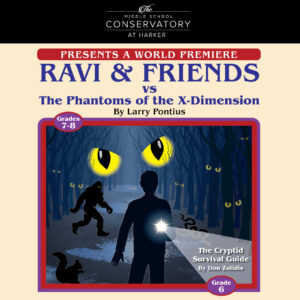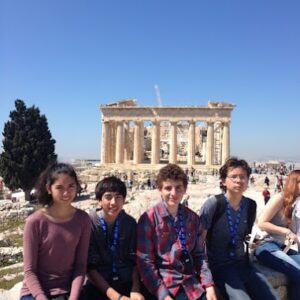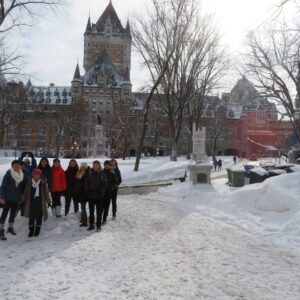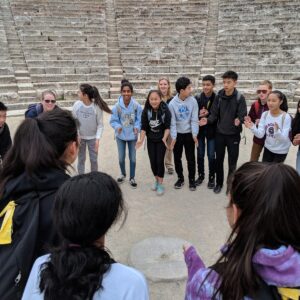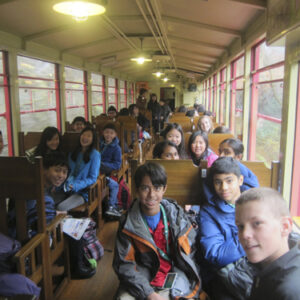This article originally appeared in the summer 2016 Harker Quarterly.
Over spring break, a group of 16 Harker history students in grades 9 and 10 took an amazing trip through Italy and Greece, absorbing the rich history and culture of both countries. The journey gave the students the rare opportunity to see many historical sites in person and hear the fascinating stories behind them.
The students, accompanied by upper school world history teacher Andrea Milius, global education director Jennifer Walrod, and upper school dance teacher Karl Kuehn, arrived in Rome after a 12-hour flight. They checked into their hotel, then headed off to dinner, which included authentic Italian pizza and fried mozzarella.
The next day they ventured to the famous Trevi Fountain and Piazza Venezia before heading to Piazza Navona for gelato. After trekking through the city and sampling more local food, they headed to the Spanish Steps for a bit of shopping, then to the Piazza Del Popolo to take in some local scenery.
A highlight of the day was a trip to Vatican City, where the group toured the lovely gardens and a museum filled with papal carriages that had been used in the last several centuries to protect the pope on international visits. At the Vatican’s renowned art galleries, the students viewed works such as the sculpture of “Laocoon and His Sons.”
They also got an up-close look at the many paintings adorning the walls and ceilings of the Sistine Chapel, including the famous works of Michelangelo and Botticelli, and took a stroll through St. Peter’s Basilica, which houses Michelangelo’s sculpture of “Pieta.” After taking a break for lunch at St. Peter’s Square, they explored the Domitilla Catacombs, which Milius observed “were comprised solely of volcanic ash, which we could scrape off.” Returning to Rome, the students enjoyed more shopping, gelato and dinner near Via del Corso before returning to their hotel to rest up.
The students got an early start on day three with an 8 a.m. bus ride to the Colosseum, where they learned that Colosseum gladiators were “criminals, slaves or men looking to pay off their debts; they were trained in a school adjacent to the structure,” wrote Nikhil Dharmaraj, grade 9, in one of several blog entries about the trip. “Because of the prize money and adoration, over time men would choose this profession.”
Their tour of the Colosseum was followed by a walk past the Arch of Titus, the Temple of Vesta, the Temple of Castor and Pollux, the Senate House and more. Their hike through Rome continued with stops at the Castel Sant’Angelo (the burial site of Hadrian, one of the “Five Good Emperors”), the Palazzo delle Esposizioni museum and Via del Corso.
The day was capped off by another delicious meal and reflections on their trip through one of the world’s most historic cities. “We are sad to leave Rome, but excited to explore Naples and Capri tomorrow,” wrote Dharmaraj.
Waking up early the next morning, the students traveled by bus to Naples, where a spectacular view of the Mediterranean Sea awaited them. The group took a boat to the nearby island of Capri, where they admired its amazing rock formations and learned about its history as a popular vacation spot for Roman emperors and home to authors such as Norman Douglas, Friedrich Alfred Krupp and Axel Munthe.
At Capri Village, the group explored the various shops and purchased products made from lemons, a fruit for which Capri is particularly famous. They then boarded a boat bound for Sorrento, where they stayed the night. After unloading their luggage, they enjoyed dinner and a sampling of Sorrento’s nightlife. “It was awesome,” reported Dharmaraj, “We bought many different things, like ties, tea cups, leather gloves, sunglasses and clothes for great prices. We even saw a mini puppet show!”
The next day, everyone traveled by bus to Pompeii, the city famous for being buried under ash and rock during the 79 A.D. eruption of Mount Vesuvius. The students viewed casts of some of the bodies discovered by archaeologists, and their tour guide gave them a look into Pompeiian daily life and commerce.
“Pompeii was a business city, so there were small businesses around every corner,” Dharmaraj wrote. “Along these streets, various items were sold: clothes, drinks and foods.”
After wrapping up their tour of Pompeii, the group boarded a ferry to Greece to begin the second stage of their trip. On their first day in Greece, the group started their lengthy trip to Delphi, stopping for lunch in Glovinos and enjoying a brief jaunt on the shore of the Ionian Sea. Upon reaching Delphi, they explored the narrow streets and local shops, and purchased food to feed the stray dogs they encountered. “From goats to stray cats and chickens, we were pleasantly surprised by the wonders of this alcove in the altitudes of Greece,” Dharmaraj wrote.
The group awoke early the next morning ready for a full day in Greece which began with a tour of Delphi’s historical sites, including the Temple of Apollo.
“Our tour guide Angelica first introduced us to some background on Delphi itself, the small town actually originally being a religious center rather than a city,” Dharmaraj reported. “Legend has it that Apollo’s first arrival in Delphi angered Mother Nature, so to reconcile with her, he demanded that priestesses instead of priests should be the main religious guides.”
These priestesses of the Oracle of Delphi were said to receive divinations by inhaling gases and then sharing their insights with visiting diplomats and rulers. Continuing on, the group also explored the ruins of the stadium, which was the site for many Olympic games. Their last stop in Delphi was a nearby museum, which housed one of only two Greek charioteer
statues left in the world. Dharmaraj briefly recounted the story of its miraculous discovery: “An earthquake buried this statue, saving it from Emperor Nero, who stole most of the others.”
On the bus trip to Athens, the group admired the Greek countryside and stopped at a local restaurant for lunch. Upon arriving, they enjoyed a short walk through the town square and briefly explored the city. That evening, they took a guided tour of the legendary Greek Orthodox church, the Metropolis, and explored the streets of Athens and its many shops and eateries before returning to their hotel for a good night’s rest.
The next morning the students toured numerous landmarks in Athens, including the statues of important Greek Civil War-era politicians and the Tomb of the Unknown Soldier.
“Whereas in America, the memorial contains a tomb of the remains of an actual unidentified soldier, the memorial in Athens is dedicated to the numerous soldiers who died in all the wars of the history of the Peloponnesian peninsula,” observed Brian Park, grade 9.
At the Acropolis, known first as a citadel for Athens and later as a place of religious significance, the students took in the wonder and history of one of the world’s most famous landmarks. “According to legend, King Cecrops, the first king of Athens who also happened to be half man half snake, built his palace there,” Park wrote. “As time passed, the Acropolis of Athens soon became a place of worship.
During the Golden Age of Athens, temples such as the Parthenon began to be constructed.” The Acropolis’ accompanying museum housed many statues that were once housed in the famous structure. “While many of the statues were damaged in some shape or form, we were able to see how careful the sculptors were in constructing them,” wrote Park.
For more student comments, details and photos from this trip, visit the Italy and Greece student blog!at http://harkeritalygreece2016. blogspot.com/. To read more global education stories, visit Harker News at https://news.harker.org/tag/ global-education.



